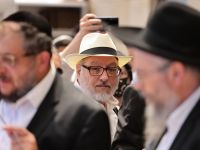By Nigel Thorpe
Over a century ago, Mark Twain was able to write “other peoples have sprung up and held their torch high for a time, but it burned out, and they sit in twilight now, or have vanished. The Jew saw them all, beat them all and is now what he always was, exhibiting no decadence, no infirmities of age, no weakening of his parts, no slowing of his energies, no dulling of his alert and aggressive mind. All things are mortal but the Jew, all other forces pass, but he remains. What is the secret of his immortality?”
The Guardian reports reviewed in the first part of this article argue that two related words – “persecution” and “isolation” - were the secret ingredients of Judaism’s immortality. But what a difference a century makes. Mark Twain’s behemoth people are now showing clear signs of ‘decadence,’ the infirmities of age, and the weakening of their divided parts. After surviving four millennia of violent history and the fires of the Holocaust, the walls of the time capsule of Orthodox Judaism are under attack from the twin corrosive forces of dissention and dissolution.
Hatred between Jew and Jew is a little-known but very ancient story. The tears of untold Jewish generations have not washed away the tribal memory that a Jew’s most deadly enemy was often not a Gentile, but another Jew. When the Jews revolted against the Romans in the first century AD, and massacred the imperial garrison in Jerusalem, it was the deadly in-fighting between rival factions of the Jewish revolutionaries that led to their eventual defeat and the destruction of the second Great Temple by the Roman Emperor Titus.
As Graham notes, these “divisions and hatred are, sadly, still here,” particularly in Israel where synagogues, both “Orthodox and non-Orthodox, are desecrated, not by Muslims, but by Jews of the opposing faction.”
By concentrating on the “dove” and “hawk” divide, the western media have missed an even deeper and more significant schism in Jewish politics. Nowhere is this division more clearly seen than in the televised sessions of the Knesset where the Ultra Orthodox party, Shas, periodically locks horns with the more liberal, secular, and more pro-western parties in prolonged and vitriolic debates. The business of the Ultra Orthodox is traditional religion while the business of the secular Israelis is business in the competitive modern world. “Jew versus Jew is a very open nerve here (in Israel),” commented Avishai Margalit, Professor of Philosophy at Jerusalem’s Hebrew University.
“There is a great deal of anti-Semitism against the Ultra Orthodox community from secular Jews. They level all the traditional anti-Semitic stereotypes against them, accusing the Ultra Orthodox, or haredim, of being parasitic, smelly, and unappealing, if not actually repellent. The Ultras, for their part, reply that their secular brethren are simply non-Jews, indeed almost blond beasts (Germans). There is a very strong antipathy between them and it’s growing all the time.”
The “Ultras” see themselves as time lords, guardians of the Semitic time capsule and their orthodox faith. To protect them from “contamination” by the secular world, Ultra Orthodox teenagers are exempt from compulsory military service. This was a highly contentious issue in the last election and with the small Shas party potentially holding the balance of power in their hands, the larger parties did not want to risk losing their support. As a result, the young “Ultras” kept their privileges and protected life style. To the majority of secular Jews in Israel, argues the Guardian report, the young “Ultras” who attend a religious college (yeshiva) and their parents are seen as unproductive members of the Jewish society and a financial burden to the State of Israel.
Besides feeling the tensions caused by the hostility between the “Ultras” and the “seculars”, many Jews living in the State of Israel are now stressed by the reversal in their traditional role: as a people, the persecuted have become the persecutors; the expelled now find themselves as the expellers; the jailed have now become reluctant jailers; the nomads have metamorphosed into settlers. Since the beginning of the current Intifada, Guardian reporter Graham Turner argues, the perceived external threat of Palestinian terrorism has replaced the persecution specter as the “unifying force” that “papers over the cracks” of internal Jewish dissent.
Turner quotes the long-term fears of many academics and political analysts who fear that a peace treaty with the Palestinians could remove the external pressure which is currently holding Israeli politics below its boiling point. Ironically, persecution is now working in the Palestinian’s favor by cementing together numerous dissident factions in their fight against a common foe - Israel.
In England, where the Jewish population does not feel itself to be under terrorist attack, the growing tensions between Orthodox Jews and their liberal Reform “cousins” are particularly evident. “All too often,” Graham Turner reports, “ there is a strong suggestion that Reform Jews are letting the side down, by putting at risk the entire future of the Jewish people.”
The sense that the Jewish community is a “house divided against itself” in doctrinal terms grows all the deeper when you listen to Liberal and Reform rabbis.” Many do not have a charitable word to say about Jonathan Sacks, the Chief Rabbi of British Jewry. In Orthodox synagogues, men and women sit separately with a mehitza, or barrier, between them while in Reform synagogues, both sexes worship together. Reform Judaism allows women to become rabbis while Orthodox rabbis are invariably men.
In addition to the lack of ‘persecution’ allowing internal divisions to grow and strengthen, Jewish communities in both the United Kingdom and the United States face a threat which is largely unknown in Israeli – “marrying-out” and the resulting “assimilation.” Whereas Orthodox Jews are strictly forbidden to “marry out,” in Reform synagogues as many as one third of the families now include a non-Jewish parent.
UK Chief Rabbi Jonathan Sacks believes that the rate of marrying out spells “massive demographic devastation and confusion.” In Britain, the Jewish community has fallen from 450,000 in the 50’s to 260,00 today. To combat this growing trend, the Ultra Orthodox living in self-imposed enclaves in parts of Manchester and London keep themselves to themselves rather than integrate with the general community. Ultra men invariably wear black hats and clothes and normally sport beards and ringlets in obedience to the Biblical injunction not to use a knife on the face. To help maintain their numbers, Graham reports, “there is an almost frantic urgency about the rate of procreation, as if there will be no tomorrow for Judaism unless vast families are produced.” The Jewish community cannot depend on conversions to boost its numbers since rabbis make joining its ranks incredibly difficult.
Graham Turner’s reports highlight the paradoxical fact that it is in America, the western country which is perceived as being the most pro-Israeli, that many Jews feel themselves to be an ’endangered species.’ The disappearance of persecution and discrimination, in-fighting between the two ‘rabbinical camps’, marrying out and assimilation into the general population have all contributed to the decline in the numbers and ‘purity’ of the Jewish community in America.
Herman Obermayer remembers his family turning up forty years ago in torrential rain at a motel in Maine where they had reservations only to be turned away because they were Jewish. “My father, who was the first Jewish president of the Philadelphia Bar, just said :’America’s been very good to us – don’t complain’.” Ruth Bader Ginsburg, another member of the American Jewish community interviewed by Turner “recalls signs outside bed-and breakfast accommodation that said simply ’no dogs or Jews’.”
“Many of my parents’ generation,” explained Adele Malpass, one of the Obermayer’s daughters,“ wanted to be part of America. They didn’t want to be different. In fact, they were worried about being different because, at that time, a lot of baggage came with it. So their religion was watered down until there was very little religion and tradition in it. It was a very ‘sanitized’ version of Judaism.”
“America is finishing Hitler’s work,” suggested James Adelman, a Jewish lawyer who lives near Chicago. “Like many Jews, I am deeply worried by the steep decline and dilution of the Jewish community in the United States because so many young Jews are ‘marrying out’.” The main problem facing American Jews is not the widening Ultra-Reform divide, or the split between the hawks and the doves, it is the fact that so many of their fledgling offspring want to flock with birds of a “very different feather.” As Turner notes, the statistics certainly look ominous; in America, six out of ten Jews marry non-Jews.
“Where there’s a mixed marriage,” commented Rabbi Ammiel Hirsch, who runs the World Union of Progressive Jewry in New York, “ only 28 percent of the children are raised Jewish. In the next generation, a mere six percent identify themselves as Jewish. So in just two generations, you’ve eliminated the Jewish line. “
The Jewish comedian Jackie Mason quips “the anti-Semites obviously got it wrong. Instead of persecuting the Jews, which only served to perpetuate Jewish identity, what they should have done was to embrace us!”
“The trouble,” Adelman concludes, ”is that America is such an open, tolerant society. You can fight an enemy who persecutes you, but how can you fight a friend who offers you a drink? In the last three years, I haven’t been to a single wedding where both partners were Jewish. I think the Jewish culture in America will simply disappear.”
Betty Nan Obermayer, wife of a former newspaper owner agrees that assimilation is inevitable and, as that goes on happening. “We’ll lose our historical identity. In its present form, Judaism in America is doomed.”
A Rabbi from New York neatly summarized the problems faced by world Jewry by saying “rabbinic Judaism was predicated on a small, excluded, closely knit minority which kept itself apart from the rest of society. It was not designed to cope with the sort of open society we’ve got now. In an open society, you mix and, if a Jewish boy falls in love with a non-Jewish girl he meets at university, what happens?” The question on many Jews’ minds in America and Britain is - can Judaism survive tolerance and kindness as successfully as it survived persecution?”
“If we don’t check the decline,” concludes Norman Lamm, president of the Yeshiva University in New York, “the story of the Jewish people could come to an end, God forbid.”
Many Jews now fear that because of its divided crew and open ‘airlocks’, the Semitic time capsule cannot possibly “be forever.” From their scattered ‘diasporic’ viewpoints across the globe, members of the two surviving tribes of Israel are beginning to fear that after a four-thousand year reprieve they will, like the ten tribes before them, be blown away by the winds of change.







